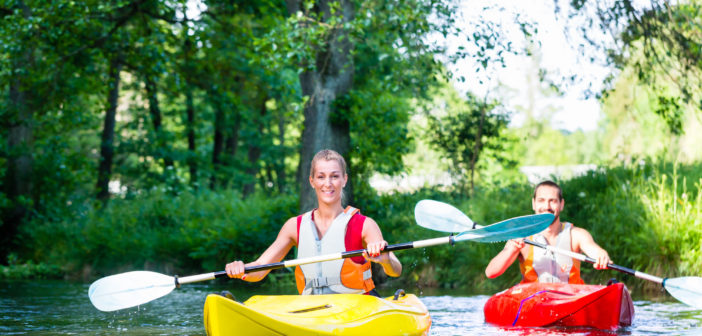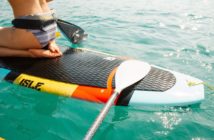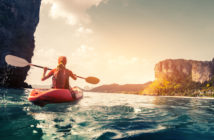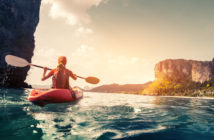Navigating a lake by canoe is one of the most relaxing and recreational water activities.
Canoeing offers fresh air and adventure in the great outdoors. It puts you in touch with the sounds and sights of nature while providing health benefits and relieving stress.
Canoe paddling provides a full body workout, strengthens muscles, and improves blood circulation. It can even burn an average of 400 calories per trip. To take full advantage of canoeing, be sure you’re practicing proper paddling and steering techniques.
Here is everything you need to know about the right way to paddle and steer a canoe.
Canoeing Basics
Like any water vessel, a canoe has a set of terms and tricks that are helpful to know.
The front of the canoe is the bow and its backside is the stern. Aft is the right side of the canoe, while the port is the left. These also get described as “on” and “off” sides, depending on which hand is getting used when paddling.
The canoe consists of a long shaft, a handle, and a blade or paddle. It differs from an oar as it is not connected to the boat, and supported by the canoer.
For newbies, balancing in a canoe can be tricky. When getting into the canoe the key is to stay low. Try sitting or kneeling until you get the hang of it.
Keeping the canoe balanced is also known as “trim.” It provides a much smoother and more enjoyable ride. Sitting up straight in the canoe is the best way to maintain balance.
When riding alone, you’ll want to store any gear in the front of the canoe. Sit more towards the back of the canoe or in the center.
You should always wear a life vest and follow proper safety procedures. Store extra life vests in the front of the canoe in case of emergency.
Canoe trips are best during the summer and fall months when the weather is most enjoyable. Take advantage of the vitamin D exposure you get during your canoe trip. You can soak up 80% of your vitamin D needs from the sun’s glare.
Learning the Strokes to Steer
When learning how to paddle a canoe, you’ll want to master the different strokes. These include forward, backstroke, and the j stroke.
The Forward Stroke
The forward stroke is your main technique for how to canoe. It involves paddling to steer your canoe in a forward direction.
When holding your paddle, the shaft should be vertical. You’ll want to turn the paddle so the wide side is facing the water. This side will then get pushed against the water.
Your “on” or water-side hand will guide the paddle into the water. Your “off” hand will sit farther up on the shaft. Thinking of canoe paddle sizing, your hands should be a few feet away from each other.
You can grab the paddle handle for support. Your other hand should grip about a foot away from the end of the paddle. This will result in less work to paddle the canoe.
Make a slight twist of the torso as you reach forward to paddle. Take the blade all the way out of the water as you move forward. For better balance, stay seated and avoid leaning too far forward as you paddle.
Be sure the entire blade dips into the water, then pull back towards the direction of the canoe’s rear. Once the blade reaches your hip, you can move the blade back out of the water.
You will feel the movement in your arm and abdomen muscles, as these work to propel the canoe forward. Using too much of your back muscles can cause discomfort.
It’s important to keep the paddle near the canoe to get the most efficient stroke. You’ll also want to follow these tips for avoiding paddling injuries.
Cross-paddling will help you stay in a straight line. To do this, switch sides every few strokes to keep a good direction and speed. Paddling on one side only will move you in a circle.
After a stroke, when the paddle reaches your hip you lift it from the water and swing it over to the other side. You will also need to rearrange your hands. Once you get the hang of it, you’ll find a rhythm and increased speed.
The Backstroke
The backstroke moves from the rear to the front of the canoe. This technique gets used to reverse or make a sharp turn. It works best in still water or at a slow speed and is like a U-turn.
Do this by paddling on one side to make a slight turn. You’ll want to paddle on the opposite side that you wish to turn. So, if making a left, paddle on the right side.
This move won’t slow you down much. Yet, it can take a few strokes to start turning the canoe.
The J Stroke
This stroke will provide a sharper turn. It involves placing the blade of your paddle in the water behind you. The blade should remain flat near the edge of the canoe, almost touching it.
You’ll them want to twist your torso and shoulders to the side, then back towards the front of the canoe. This will work the paddle like a rudder. It will then turn the canoe towards the side the paddle is on.
The blade should remain in the water as you do this. This technique will slow the canoe down more than the back-stroke.
The j stroke is also referred to as a back sweep. The greater the size of the stroke, the more momentum you will create to move the canoe in a different direction.
The Side Stroke
The side stroke gets used if you want to move the canoe parallel through the water. It works by either pushing the paddle away from the canoe or towards the canoe.
Pushing it away from the canoe will move you in the opposite direction. Pushing the paddle towards you will move you in the same direction that the paddle sits on.
When using this canoe paddle technique, it’s important to keep your arms straight. You’ll also want the paddle staying verticle.
Canoe Paddling with Two People
Two-person canoes are a great way to share the scenery and the effort of moving and steering your canoe.
Balance is key, and the two people must work together. One person sits in the front (the bowman) and the other in the back (the sternman).
In tandem canoeing, the Bowman leads the strokes and controls the speed. The sternman has a better view and can match pace with the bowman. The sternman takes control of steering and direction.
Paddling with a partner should get synchronized. It’s best for each person to pick an opposite side to paddle on. You’ll need to work out a system so you both switch on the same stroke.
Moving and steering the canoe is easy with two people. The person sitting in the rear can perform the backstrokes. The person sitting in the front can use the opposite side to do a forward stroke.
Preparing for Your Next Outdoor Adventure
Once you learn the ins and outs of canoe paddling, you can also apply it to other outdoor water sports. Try your new skills out on kayaking and paddleboarding.
Planning your next outdoor adventure? Get inspired for your next trip with this list of the best places to kayak in the world.




